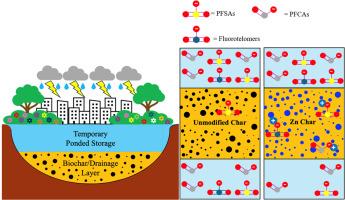Tailored carbonaceous materials as biofilter amendments for PFAS removal in stormwater runoff
IF 12.4
1区 环境科学与生态学
Q1 ENGINEERING, ENVIRONMENTAL
引用次数: 0
Abstract
This study investigates the efficacy of metal-modified biochar (metal char) as biofilter amendments for the removal of six per- and polyfluoroalkyl substances (PFAS) in stormwater runoff. The metal identity (i.e., Zn, Al, and Fe) and production conditions substantially influenced the performance of metal char, with Zn Char exhibiting a greater surface area (586.28 m2 g−1), smaller pore size (3.44 nm), higher metal content (5.53 % w/w), and highest affinity toward PFAS compared to Al and Fe Char. Zn Char’s enhanced PFAS removal was attributed to the synergistic effects of increased surface area, optimized porosity, and localized electrostatic interactions with metal oxide domains. Structural differences among the six PFAS, including carbon chain length, terminal head group, and degree of fluorination, strongly influenced their adsorption kinetics and capacity. Batch experiments revealed that Zn Char demonstrated substantially enhanced PFAS removal compared to unmodified char, achieving adsorption performance that closely tracked granular activated carbon (GAC) for long-chain PFAS. Under variable flow conditions, Zn Char delayed the PFAS breakthrough compared to unmodified char and tracked GAC performance despite being used at higher doses, with particularly enhanced retention for PFOA and 6:2 FtS. While PFOS showed no breakthrough during both storm events, short-chain PFAS exhibited rapid breakthrough but with improved retention by Zn Char relative to unmodified biochar. These findings highlight metal char as a promising alternative to conventional adsorbents for PFAS removal in dynamic flow conditions experienced during stormwater management.


定制碳质材料作为去除雨水径流中PFAS的生物过滤器
本研究探讨了金属改性生物炭(金属炭)作为去除雨水径流中六全氟烷基和多氟烷基物质(PFAS)的生物过滤器改进剂的效果。金属同一性(即Zn、Al和Fe)和生产条件对金属炭的性能有很大影响,与Al和Fe炭相比,Zn炭表现出更大的表面积(586.28 m2 g−1),更小的孔径(3.44 nm),更高的金属含量(5.53% w/w),对PFAS的亲和力最高。Zn Char对PFAS去除效果的增强是由于比表面积的增加、孔隙度的优化以及与金属氧化物域的局部静电相互作用的协同作用。6种PFAS的碳链长度、末端头基团和氟化程度等结构差异对其吸附动力学和吸附容量有很大影响。批量实验表明,与未改性的炭相比,Zn炭对PFAS的去除效果显著增强,其吸附性能与颗粒活性炭(GAC)对长链PFAS的吸附性能相当。在不同的流动条件下,与未改性的炭相比,锌炭延迟了PFAS的突破,尽管锌炭的使用剂量更高,但其对PFOA和6:2 ft的保留率特别高。PFOS在两次风暴中均未表现出突破,而短链PFAS表现出快速突破,但相对于未改性的生物炭,锌炭的保留率有所提高。这些发现突出表明,在雨水管理过程中经历的动态流动条件下,金属炭作为传统吸附剂去除PFAS的有希望的替代品。
本文章由计算机程序翻译,如有差异,请以英文原文为准。
求助全文
约1分钟内获得全文
求助全文
来源期刊

Water Research
环境科学-工程:环境
CiteScore
20.80
自引率
9.40%
发文量
1307
审稿时长
38 days
期刊介绍:
Water Research, along with its open access companion journal Water Research X, serves as a platform for publishing original research papers covering various aspects of the science and technology related to the anthropogenic water cycle, water quality, and its management worldwide. The audience targeted by the journal comprises biologists, chemical engineers, chemists, civil engineers, environmental engineers, limnologists, and microbiologists. The scope of the journal include:
•Treatment processes for water and wastewaters (municipal, agricultural, industrial, and on-site treatment), including resource recovery and residuals management;
•Urban hydrology including sewer systems, stormwater management, and green infrastructure;
•Drinking water treatment and distribution;
•Potable and non-potable water reuse;
•Sanitation, public health, and risk assessment;
•Anaerobic digestion, solid and hazardous waste management, including source characterization and the effects and control of leachates and gaseous emissions;
•Contaminants (chemical, microbial, anthropogenic particles such as nanoparticles or microplastics) and related water quality sensing, monitoring, fate, and assessment;
•Anthropogenic impacts on inland, tidal, coastal and urban waters, focusing on surface and ground waters, and point and non-point sources of pollution;
•Environmental restoration, linked to surface water, groundwater and groundwater remediation;
•Analysis of the interfaces between sediments and water, and between water and atmosphere, focusing specifically on anthropogenic impacts;
•Mathematical modelling, systems analysis, machine learning, and beneficial use of big data related to the anthropogenic water cycle;
•Socio-economic, policy, and regulations studies.
 求助内容:
求助内容: 应助结果提醒方式:
应助结果提醒方式:


